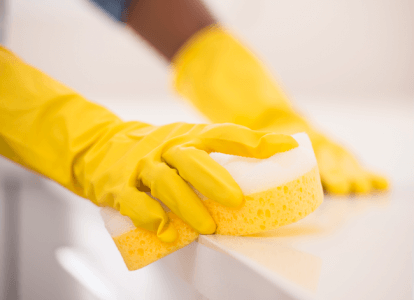Hand Sanitizer Linked to Children's Eye Injuries

Do public hand sanitizer dispensers need to be kid-proofed? A new study is linking hand sanitizer to chemical eye injuries in children. Now, doctors and researchers are warning about the potential dangers of hand sanitizer stations in public, especially the ones that are at children’s eye level and have a higher risk of squirting alcohol-based sanitizer into their eyes.
A study published in the January 2021 issue of JAMA Ophthalmology found that the increasing use of alcohol-based hand gel sanitizers has led to an increase in eye injuries among children. These chemical injuries are the result of children getting hand sanitizer into their eyes.
The increase in cases is attributed to the rise in sanitizing dispensers in public. Due to the COVID-19 pandemic, hand sanitizer dispensers and stations have popped up all over -- in schools, grocery stores, restaurants, shopping malls, offices, and public transportation stations.
According to data from the French Poison Control Center, cases among children with eye exposure to hazardous chemicals in hand sanitizer increased seven-fold between April 1 and August 24, 2020 versus the same time period one year earlier. In 2020, 63 cases of exposure occurred in a public place compared to zero cases in 2019.
French researchers say it’s likely because hand gel dispensers are typically about 3 feet high. While this is waist level for most adults, this is eye level for young children. Many of them are automatic and hands-free, meaning a child can simply place their hands underneath the opening to trigger a stream of hand gel. When children use the dispensers, hand gel coming out at their eye level may inadvertently get into their eyes. Another cause of eye injuries is due to kids touching or rubbing their eyes while the sanitizer is still wet on their hands.
Researchers say while alcohol-based hand sanitizers are an important tool in the fight against the spread of COVID-19, parents are advised to keep their children away from these public dispensers and to use caution when allowing their children to use gel-based sanitizers. Young children should never be allowed to access a hand sanitizing dispenser in a public area.
"With the current widespread use of hand sanitizer in public places, it is not unexpected that young children would be drawn to these dispensers, many of which appear to be inadvertently designed to facilitate contact between the hand sanitizer and young eyes," said Kathryn Colby, MD, PhD, from the New York University Grossman School of Medicine Department of Ophthalmology in a commentary on the research.
Based on the research findings, the key takeaways to parents are:
-
Be aware of the potential risks of hand gel sanitizers
-
Keep your children away from hand sanitizer dispensers when out in public
-
Teach your kids how to use hand sanitizers safely (train them to rub it over both sides of their hands until it is completely dry)
Researchers are recommending the following:
-
Lower dispensers in public, especially in places children are more likely to visit
-
Place caution signs next to public sanitizing dispensers warning of risks
-
Create public awareness campaigns to make sure parents know the potential dangers of alcohol-based hand gels and to keep their children away from public hand sanitizer dispensers
-
Continue promoting hand washing with soap and water over hand gels
If you suspect your child may have any hand sanitizer in their eyes, it’s critical that you irrigate the impacted eye with fresh clean water immediately, then take them to a medical professional. “Chemical injuries vary in severity, from mild and self-limited to severe and vision-threatening or even globe-threatening,” said Dr. Colby. Early diagnoses and quick treatment is essential to preventing or minimizing long-term damage of chemical eye injuries.
Another possible way to prevent these types of eye injuries or minimize the likelihood of them happening is to use antibacterial hand wipes instead of gel sanitizers. The wipes are easy for children to use and then throw away, with minimal risk to getting into their eyes. Plus, the added benefit of wet wipes is that they also wipe away dirt and grime, something gels can’t do.
It’s important to note that hand wipes vary by brand. Some kill only bacteria, while others kill both bacteria and viruses. Be sure to read the label to understand what the product is effective against. Hand wipes like Nice ’N CLEAN® Sani-Hands® Antibacterial Hand Wipes are effective in killing 99.9% of common household bacteria. You can stock up at select locations of these retailers: Costco, Walmart, CVS, Kroger, Meijer, Harris Teeter, Fry’s. They’re also available online at Walmart.com, Amazon, and on our website.
References
- Pediatric Eye Injuries by Hydroalcoholic Gel in the Context of the Coronavirus Disease 2019 Pandemic. JAMA Ophthalmol. Published online January 21, 2021. doi:10.1001/jamaophthalmol.2020.6346
- Hand Sanitizer–Induced Ocular Injury: A COVID-19 Hazard in Children. JAMA Ophthalmol. Published online January 21, 2021. doi:10.1001/jamaophthalmol.2020.6351
- Unintended Consequences of Hand Sanitizer Use in the Coronavirus Disease 2019 Pandemic. JAMA Ophthalmol. Published online January 21, 2021. doi:10.1001/jamaophthalmol.2020.6327




